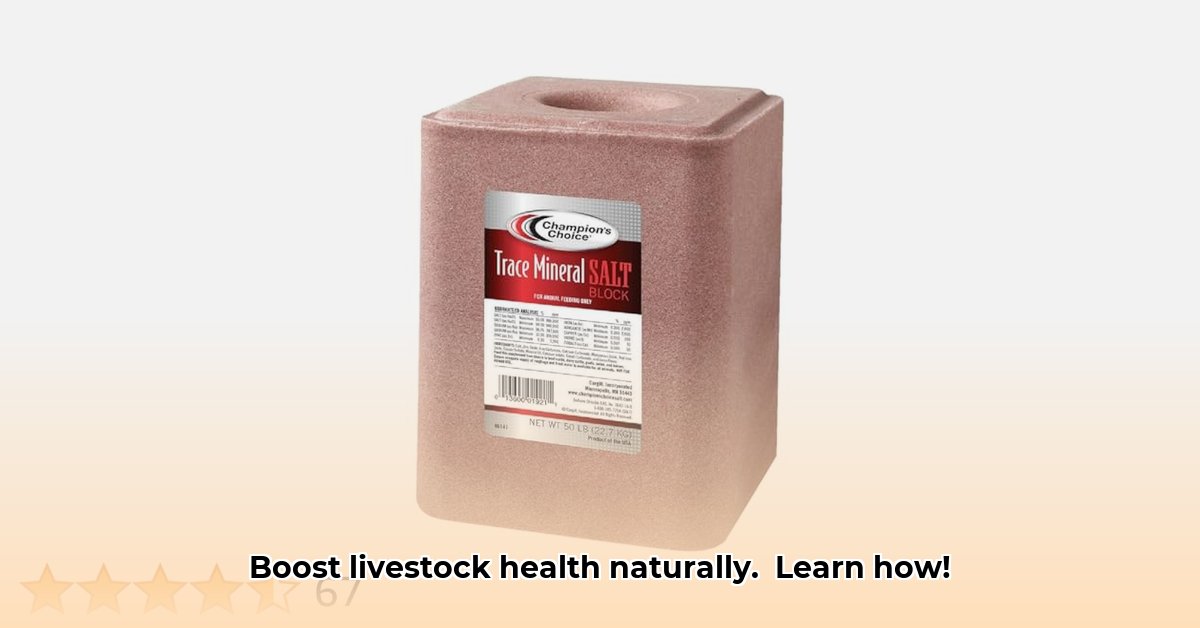
Keeping your livestock healthy and thriving involves providing essential nutrients, and salt is a crucial component. Salt blocks offer a convenient method for supplementation, but choosing and using them sustainably is critical for both animal welfare and environmental responsibility. This guide provides actionable steps to optimize salt block usage on your farm, regardless of your supplier. For more information on sustainable pasture management, check out this helpful resource: Ryegrass information.
Selecting the Right Salt Block
Choosing the appropriate salt block requires careful consideration of your animals' specific needs and your farm's unique circumstances.
- Animal Species and Size: Different animals have varying mineral requirements. A salt block suitable for cattle may not meet the needs of smaller animals like sheep or goats. Always check the product label to ensure it's appropriate for your livestock.
- Mineral Composition: Basic salt blocks provide sodium and chloride, but many also include trace minerals like magnesium, zinc, and phosphorus. Consider your animals' diet and the potential for mineral deficiencies in your pasture. A forage analysis can pinpoint deficiencies, guiding your selection. Consult with a veterinarian or agricultural extension agent for personalized recommendations.
- Block Size and Type: Larger blocks may be more cost-effective in the long run but increase the risk of waste if consumption isn't monitored carefully. Smaller blocks are easier to manage, especially for smaller animals or in areas with limited space. Alternatives, such as loose salt or mineral tubs, also exist and may prove more sustainable depending on your circumstances.
Smart Placement for Optimal Access and Reduced Waste
Strategic placement of salt blocks is crucial for ensuring all animals have equal access and minimizes environmental impact.
- Protection from the Elements: Place salt blocks in shaded areas to prevent melting in hot weather and protect them from rain and snow which can reduce their effectiveness and cause waste.
- Equal Access for All: For larger herds, distribute blocks throughout the pasture to avoid competition and ensure every animal receives sufficient supplementation. Observe your animals' grazing patterns to strategically place the blocks.
- Durable Holders: Using weather-resistant holders not only protects the blocks but helps minimize waste by preventing breakage and erosion from the elements.
Monitoring and Waste Management: A Key to Sustainability
Regular monitoring of consumption patterns is essential for efficient resource management and identifying potential problems.
- Regular Inspections: Check salt blocks frequently to assess consumption rates. Rapid depletion could indicate a deficiency, while slow consumption points to potential issues with accessibility or palatability. If consumption is too slow, you might improve the accessibility to improve efficiency.
- Waste Reduction: Proper placement substantially reduces waste. Addressing accessibility or weather-related issues will greatly improve the efficiency of your salt block usage. Consider alternative methods. Loose salt is less prone to wastage than blocks but requires secure storage and careful handling to avoid environmental contamination.
Sustainability: Integrating Environmental Responsibility
Sustainable livestock management prioritizes responsible resource use. This means adopting environmentally-conscious strategies when utilizing salt blocks.
- Sustainable Sourcing: Choose suppliers committed to sustainable practices, including responsible mining and minimum packaging. Buying local reduces transportation emissions.
- Packaging Considerations: Opt for salt blocks with minimal or recyclable packaging to lower your environmental footprint.
- Long-Term Planning: Salt supplementation is a crucial part of a holistic livestock management strategy that integrates animal health, productivity, and environmental responsibility.
Weighing the Pros and Cons: A Balanced Perspective
Salt blocks offer several benefits, but it's crucial to acknowledge potential drawbacks:
| Feature | Pros | Cons |
|---|---|---|
| Convenience | Easy to use and requires minimal handling. | Potential for uneven salt intake and resulting health issues. |
| Cost-Effectiveness | Can be cost-effective compared to some other mineral supplements | Waste potential if not properly managed; may be more expensive than some bulk options. |
| Environmental Impact | Reduced packaging compared to loose salt; locally sourced options minimize transport emissions | Potential for environmental contamination if not managed properly. |
By following these guidelines, you can effectively utilize salt blocks while contributing to both the health of your livestock and the sustainability of your farming operation. Remember, ongoing monitoring and adaptation are vital to maximizing efficiency and minimizing environmental impacts.